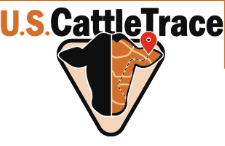By Larry Stalcup Contributing Editor
 Cattle diseases can be catastrophic to the beef industry, so isolating infected cattle is critical. To benefit helpless herds, U.S. CattleTrace, Inc., is enhancing its mission to identify the origin of diseased cattle before they infect others across the beef production supply chain.
Cattle diseases can be catastrophic to the beef industry, so isolating infected cattle is critical. To benefit helpless herds, U.S. CattleTrace, Inc., is enhancing its mission to identify the origin of diseased cattle before they infect others across the beef production supply chain.
For the worst of examples, reference back to BSE’s assault on Christmas markets in December 2003. It took years to rebuild America’s beef export market and restore consumer confidence.
U.S. CattleTrace provides a tool to help locate and isolate cattle across the nation that develop diseases. Whether they threaten a sale barn in South Dakota or a feedyard in Texas, data uploaded to the organization’s database can help minimize the spread of disease, says Callahan Grund, U.S. CattleTrace executive director “
The concept of disease traceability is not new,” Grund says. “However, there has been a shift in mindset in recent years. Today, industry stakeholders across the U.S. recognize the need for a viable, end-to-end cattle disease traceability system.”
The current initiative is an offshoot of the CattleTrace Pilot Project, which was formally established in Kansas in 2018. It is a private, not-for-profit corporation that aims to securely maintain and manage contact-tracing data collected for disease traceability. To help ensure data privacy and protection, its board of directors is voted on by the membership and includes representatives from the cow-calf, livestock market and feedyard sectors.
U.S. CattleTrace IDs work at the ranch, sale barn and feedyard.
With interest and further pilot projects in other states, the name was changed to U.S. CattleTrace, Inc. in early 2020. Headquartered in Wamego, Kan., it is now supported by the National Cattlemen’s Beef Association (NCBA) and 10 state or regional cattle organizations.
“Our members include cow-calf producers in more than 20 states, feedyard operators that market about 2.2 million cattle annually and auction markets that market more than 2 million cattle,” Grund says. “We’re eager to gain more members to get involved in disease traceability. We encourage producers and feedyards to engage in our program to learn how their PREVENT DISEASE SPREAD U.S. CattleTrace Has the Prescription But Needs More Producer and Feeder MembersBy Larry Stalcup Contributing Editoroperation can benefit from it.”
The program involves the secure collection of data from common electronic ear tags already widely used in herds and feedyards to measure performance, input costs and other data. Tags are typically equipped with radio frequency identification (RFID) technology.
Livestock information is collected from RFID tags and entered into the U.S. CattleTrace database. In collecting information, four data points are measured: date, time, GPS location and identification number of the scanned animal.
“Once in the database, the data can only be accessed in the case of a disease outbreak, by U.S. CattleTrace staff via a multistep authentication process,” Grund says. “It’s another tool for animal health officials to hone-in and isolate a disease source to keep it from spreading.”
Any request for use of data by animal health officials must be approved by a majority of the U.S. CattleTrace Board of Directors via a formal vote. Information will be provided based upon a disease-risk matrix developed by industry experts alongside the board of directors.
NCBA has adopted a policy in support of U.S. CattleTrace. State and regional producer and feeder associations that support the organization through membership include: Florida Cattlemen’s Association, Iowa Cattlemen’s Association, Kansas Livestock Association, Kentucky Cattlemen’s Association, Missouri Cattlemen’s Association, Nebraska Cattlemen, Oklahoma Cattlemen’s Association, Texas Cattle Feeders Association, Texas and Southwestern Cattle Raisers Association and Washington Cattle Feeders Association.
Annual membership costs are based on the type of operation. For cow-calf producers and dairy producers, memberships are $25. For feedyards, membership is $50 per location for yards with up to 2,500 capacity; $200 per location for 2,501- to 10,000-head capacity; $500 per location for 10,001- to 20,000-head capacity; and $1,000 per location for 20,001 or more capacity.
The membership for an auction market is $100 Memberships are also available for allied industries and producer associations.
Members can buy RFID tags at a discount through U.S. CattleTrace, which has partnered with tag distributors. Members may buy RFID tags from the web page and have them shipped directly to their operations. Members may also receive discounts on tags that can be used for disease traceability. The process includes tags distributed for free from the U.S. Department of Agriculture.
“Disease traceability is an important component in the overall biosecurity of the U.S. beef cattle industry,” Grund says. “It plays a significant role in resuming and maintaining commerce in the event of a disease outbreak.
“It provides critical tools to manage a disease outbreak, and the technology that is used offers producers the opportunity to add value to their operations. It’s an investment that should benefit producers of all sizes.”
Of course, there’s hope U.S. CattleTrace isn’t forced to isolate a case of BSE in the United States. But if such a disease is discovered, the value of such isolation thanks to a simple $25 annual membership will be multiplied many times over.
For more on U.S. CattleTrace membership, RFID tags and overall guidelines, visit https://www.uscattletrace.org.






